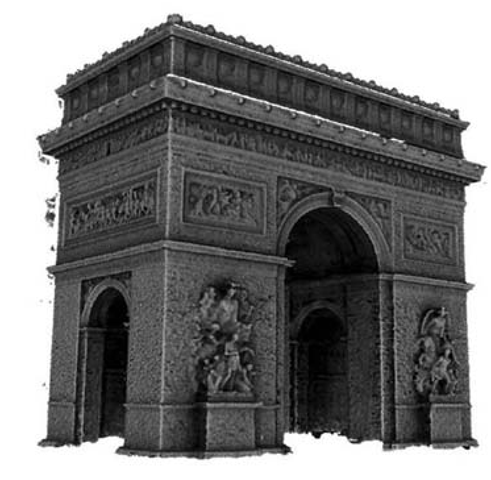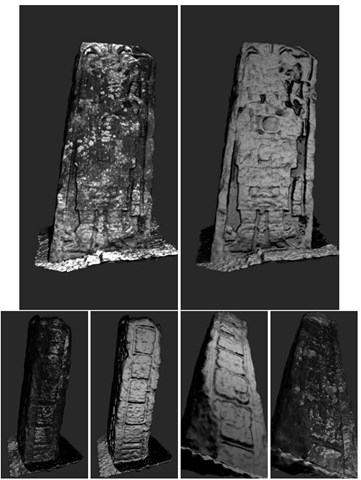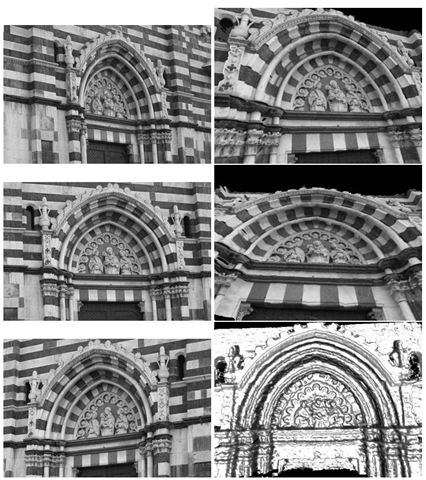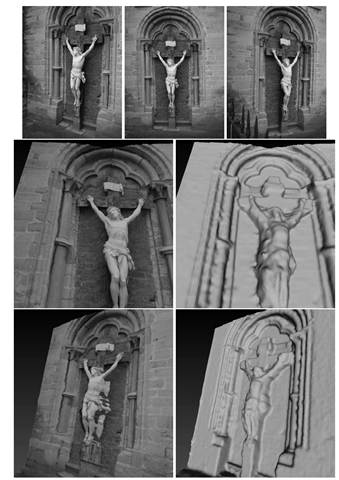Result
After submitting the sequences to ARC3D and obtaining the results, the resulting depth maps were imported into MeshLab for post processing. The Poisson Reconstruction [9] tool was used to remove noise and to close holes. ARC3D reconstructs all meshes in their own reference frame, since no information about global position and orientation (aka geo-reference) can be obtained from the images only. Before merging two sequences, the meshes thus had to be transformed into an arbitrary, but common, reference frame. This can be done manually by picking one of the meshes as reference, to which frame the other meshes are scaled, rotated, and translated. Manually transforming the meshes is a time-consuming task, and in this case we used a newly developed tool which performs this automatically. This function is intended to be available to the public in future versions of ARC3D. A video displaying the complete model was rendered using Blender [10], an open-source software package for 3D modeling. Figure 4.12 and Figure 4.13 show some of its snapshots. For a more complete experience, we encourage the reader to watch the video present in the 3D gallery section of the ARC3D website [4].
FIGURE 4.15
Image viewpoints for Arc de Triomphe sequence. Note that it was impossible to capture images from the middle of the boulevards radiating from the Place de l’Etoile.
Examples
The previous section showed how ARC3D can be employed for the 3D reconstruction of an enclosed environment such as a cave. In computer vision parlance, this is an inside-out type of problem. In this section, a number of other scenarios are demonstrated to show ARC3D’s capability of dealing with a wide variety of scenes.
A Complete Building: Arc de Triomphe
As a first, complementary example, we take an “outside-in” type of scene, where the camera is moved around the object of interest. The Arc de Triomphe, one of the best known buildings of Paris, was reconstructed using 106 images. Some of those can be seen in Figure 4.14. The open space surrounding the landmark permits the capturing of images from all possible directions. This makes it possible to reconstruct the Arc de Triomph from one long sequence of images. Shooting was made along a mostly circular trajectory around the landmark, as displayed in Figure 4.15, based on ARC3D output about the camera positions. The result is a complete 3D model, which can be seen in Figures 4.16 and 4.17.
Another similar example, but of lower scale, is the reconstruction of a stelae. These stone pillars are typically surrounded by open space and may also be reconstructed in one shooting. Figure 4.18 shows a reconstruction of a stelae from the Calakmul archaeological site in Mexico. Interesting to see is that the inscriptions on the stelae, which are only vaguely visible to the human eye, can clearly be perceived when the texture is removed.
Environment Scene
ARC3D is not only able to reconstruct individual objects; complete models of natural environments can also be created. Figure 4.19 shows the reconstruction of a mountain scene in Alberta, Canada.
FIGURE 4.16
3D reconstruction of Arc de Triomphe.
FIGURE 4.17
3D reconstruction of Arc de Triomphe.
FIGURE 4.18
Reconstruction of a stelae in Calakmul, Mexico. When the texture is removed, the legibility of the carvings is greatly increased.
FIGURE 4.19
Three of the 30 input images (top row) and the resulting reconstruction of a mountain range.
FIGURE 4.20
Duomo, Prato, Italy. Some of the uploaded images are shown to the left and reconstruction to the right.
FIGURE 4.21
Christ statue at Park Abbey, Leuven, Belgium. The overall scene is well reconstructed but additional close-up images of the statue could have provided finer details.
Conclusions
For a broad range of objects and scenes, self-calibrating 3D reconstruction methods based solely on images are a viable option. ARC3D is such a system, which is freely available as a web service for non-commercial use.
In the future, we plan to extend this web service in several ways. On the agenda are the creation of more automated tools for putting the depth maps into registration, for the extraction of more consistent textures, and for the use of omni-directional images (rather than the perspective images used exclusively now).







